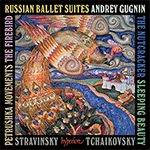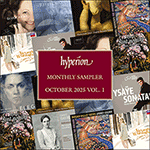
Welcome to Hyperion Records, a British classical label devoted to presenting high-quality recordings of music of all styles and from all periods from the twelfth century to the twenty-first.
Hyperion offers both CDs, and downloads in a number of formats. The site is also available in several languages.
Please use the dropdown buttons to set your preferred options, or use the checkbox to accept the defaults.

| Andrey Gugnin (piano)» More |

Some of the numbers appear in the Nutcracker orchestral suite. The ‘March’ opens the proceedings with excitement and grandeur: the Christmas tree has been lit, and a fantastical children’s party is about to begin. The piano version moves from compact chords to brilliant runs spanning the whole keyboard.
The ‘Dance of the Sugar Plum Fairy’ is a divertissement in Act 2 of the ballet, and it takes place in the Land of Sweets, a kind of children’s paradise. The very distinctive sounds of the celeste and harp in the original are conveyed so well in the arrangement that the listener feels that nothing is lost. Tchaikovsky encountered the celeste in Paris, not long after its invention, and he kept it a closely guarded secret before the premiere of The Nutcracker.
The ‘Tarantella’ in the ballet is the dance of Prince Orgeat (originally Prince Coqueluche), the partner of Sugar Plum Fairy. Tarantellas are usually frenetic, and Tchaikovsky rises to the challenge here, although there are also hints of lyricism and even sadness that performers can bring out if they choose.
The ‘Intermezzo’ is one of the most mysterious numbers: it comes from the last scene of Act 1, where the young protagonist, Clara, leaves reality behind and enters the other world. Tchaikovsky constructs his melody from the simplest of materials, but he builds it up until it finds its consummation in a grand but moving apotheosis. As Clara leaves this world, there is sequence of ‘magical’ chords. Pletnev reins in the virtuosity somewhat, to leave the noble and mysterious character of the piece to speak for itself.
The fiery ‘Trepak’ comes from the parade of nationalities in the Act 2 divertissement. It is a dance-till-you-drop conceit that inspired Stravinsky’s ‘danse russe’ in Petrushka. Here Pletnev allows himself more freedom to create an exciting pianistic romp. The special charm of the ‘Chinese dance’ comes from the use of extreme registers: there is a highly agile melody played by flute and piccolo, and busy oscillations in the bass instruments. The piano conveys this equally well—passages played at opposite ends of the keyboard had featured in piano music from Beethoven onwards.
Finally comes the andante maestoso, a beautiful and poignant song of love and life. In the original form of the ballet, this pas de deux was danced by the rulers of the Sweet Kingdom: Sugar Plum Fairy and Prince Coqueluche. In later productions (after Tchaikovsky’s death) it was given to the principal couple, Clara and the Prince, where it puts a fitting end to their love story (the Nutcracker of the earlier scenes is transformed into the Prince). As often in Tchaikovsky, the great climactic statement is perched on the brink of tragedy, adding a deeper dimension to what is often imagined to be an innocuous fairytale.
from notes by Marina Frolova-Walker © 2025
Certains numéros figurent dans la suite pour orchestre de Casse-noisette. La «Marche» ouvre les opérations avec enthousiasme et grandeur: l’arbre de Noël a été allumé et une fantastique fête pour les enfants est sur le point de commencer. La version pianistique passe d’accords compacts à des traits brillants couvrant l’intégralité du clavier.
La «Danse de la Fée Dragée» est un divertissement situé à l’acte 2 du ballet qui se déroule au Pays des délices, une sorte de paradis des enfants. Les sons très caractéristiques du célesta et de la harpe dans l’original sont si bien traduits dans l’arrangement que l’auditeur a l’impression de rien n’est perdu. Tchaïkovski découvrit le célesta à Paris, peu après son invention, et il en fit un secret bien gardé jusqu’à la création de Casse-noisette.
Dans le ballet, la «Tarentelle» est la danse du Prince Orgeat (à l’origine le Prince Coqueluche), partenaire de la Fée des Dragées. Les tarentelles sont généralement trépidantes et Tchaïkovski relève ici le défi, même s’il y a des touches de lyrisme et même de tristesse que peuvent faire ressortir les exécutants s’ils le veulent.
L’«Intermezzo» est l’un des plus mystérieux numéros: il provient de la dernière scène de l’acte 1, où la jeune protagoniste, Clara, laisse la réalité derrière elle et entre dans l’autre monde. Tchaïkovski construit sa mélodie à partir de matériels très simples, mais il la développe jusqu’à ce qu’elle trouve son aboutissement dans une apothéose grandiose mais émouvante. Lorsque Clara quitte ce monde, il y a une séquence d’accords «magiques». Pletnev réfrène un peu la virtuosité, pour laisser le caractère noble et mystérieux de la pièce parler de lui-même.
Le «Trepak» enflammé vient du défilé de nationalités dans le divertissement de l’acte 2. C’est un concept de danse jusqu’à épuisement qui inspira à Stravinski la «danse russe» de Petrouchka. Ici, Pletnev s’accorde davantage de liberté pour créer des ébats pianistiques passionnants. Le charme particulier de la «Danse chinoise» vient de l’utilisation des registres extrêmes: une mélodie très vive jouée par la flûte et le piccolo, et des oscillations animées aux instruments graves. Le piano le traduit aussi très bien—on trouve des passages joués aux extrémités opposées du clavier dans la musique pour piano à partir de Beethoven.
Vient enfin l’andante maestoso, un magnifique et poignant chant d’amour et de vie. Sous sa forme originale dans le ballet, ce pas de deux était dansé par les dirigeants du Pays des délices, la Fée Dragée et le Prince Coqueluche. Dans des productions ultérieures (après la mort de Tchaïkovski), il fut confié au couple principal, Clara et le Prince, où il met fin de façon appropriée à leur histoire d’amour (le Casse-noisette des scènes antérieures est transformé en Prince). Comme souvent chez Tchaïkovski, la grande exposition décisive est nichée au seuil de la tragédie, ajoutant une dimension plus profonde à ce que l’on considère souvent comme un conte de fées innocent.
extrait des notes rédigées par Marina Frolova-Walker © 2025
Français: Marie-Stella Pâris
Einige der Nummern finden sich in der Orchestersuite des Nussknackers. Der „Marsch“ eröffnet das Ganze mit Pracht und Begeisterung: der Weihnachtsbaum leuchtet, und ein fantastisches Kinderfest steht bevor. Die Klavierfassung wechselt von kompakten Akkorden zu brillanten Läufen, die die gesamte Tastatur umspannen.
Der „Tanz der Zuckerfee“ ist ein Divertissement im zweiten Akt des Balletts und findet in der „Konfitürenburg“ statt, einer Art Kinderparadies. Die im Original äußerst charakteristischen Klänge von Celesta und Harfe werden in der Bearbeitung so gut wiedergegeben, dass der Zuhörer nichts vermisst. Tschaikowsky lernte die Celesta in Paris nicht lange nach ihrer Erfindung kennen und hielt sie bis zur Uraufführung des Nussknackers streng geheim.
Die „Tarantella“ im Ballett ist der Tanz von Prinz Orgeat (ursprünglich Prinz Coqueluche), der Partner der Zuckerfee. Tarantellen sind in der Regel frenetische Tänze, und Tschaikowsky stellt sich dieser Herausforderung, obwohl es auch Andeutungen von Lyrik und sogar Traurigkeit gibt, die die Interpreten hervorheben können, wenn sie wollen.
Das „Intermezzo“ ist eine der geheimnisvollsten Nummern. Es stammt aus der letzten Szene des ersten Aktes, in der die junge Protagonistin Clara die Realität hinter sich lässt und in die andere Welt eintritt. Tschaikowsky konstruiert seine Melodie aus einfachstem Material und steigert sie, bis sie ihren Höhepunkt in einer großen, aber bewegenden Apotheose findet. Als Clara diese Welt verlässt, erklingt eine Folge von „magischen“ Akkorden. Pletnev hält die Virtuosität etwas zurück, um den edlen und geheimnisvollen Charakter des Stücks für sich selbst sprechen zu lassen.
Der feurige „Trepak“ entstammt der Parade der Nationalitäten im Divertissement des zweiten Aktes. Es handelt sich um einen äußerst energischen Tanz, welcher Strawinskys „danse russe“ in Petruschka inspirierte. Hier erlaubt sich Pletnev mehr Freiheiten, um für ein aufregendes pianistisches Treiben zu sorgen. Der besondere Reiz des „Chinesischen Tanzes“ liegt in der Verwendung extremer Register: es gibt eine sehr agile Melodie, die von Flöte und Piccoloflöte gespielt wird, sowie geschäftiges Hin- und Herpendeln in den Bassinstrumenten. Das Klavier bringt dies ebenso gut zum Ausdruck—Passagen, die an den entgegengesetzten Enden der Tastatur gespielt werden, gibt es in der Klaviermusik seit Beethoven.
Schließlich folgt das Andante maestoso, ein wunderschönes und ergreifendes Lied über die Liebe und das Leben. In der ursprünglichen Fassung des Balletts wurde dieser Pas de deux von den Herrschern des süßen Königreichs, der Zuckerfee und Prinz Coqueluche, getanzt. In späteren Inszenierungen (nach Tschaikowskys Tod) wurde er dem Hauptpaar, Clara und dem Prinzen, gegeben, wo er ihrer Liebesgeschichte ein passendes Ende setzt (der Nussknacker aus den früheren Szenen verwandelt sich in den Prinzen). Wie so oft bei Tschaikowsky ist der große Höhepunkt am Rande der Tragödie angesiedelt und verleiht dem oft als harmlos empfundenen Märchen eine tiefere Dimension.
aus dem Begleittext von Marina Frolova-Walker © 2025
Deutsch: Viola Scheffel
 Tchaikovsky & Stravinsky: Russian Ballet Suites Tchaikovsky & Stravinsky: Russian Ballet SuitesWhether offering new and unexpected insights into the original works, or—given the pianistic pedigree associated with the genre—the opportunity to astonish the listener with displays of pyrotechnics, piano transcriptions work on various levels. Be ...» More |
 Hyperion sampler - October 2025 Vol. 1 Hyperion sampler - October 2025 Vol. 1 |

